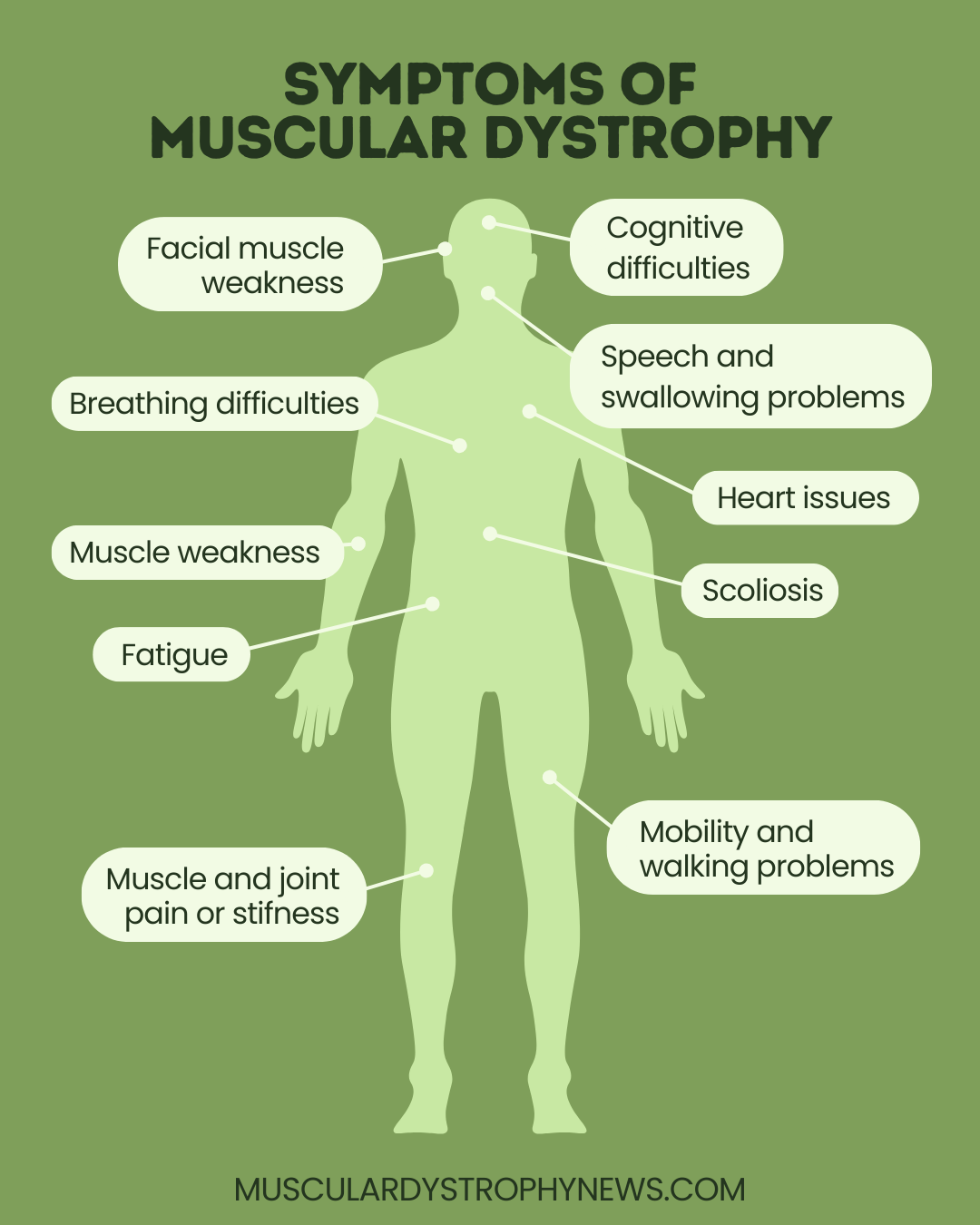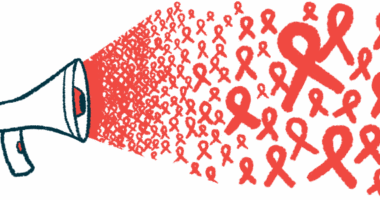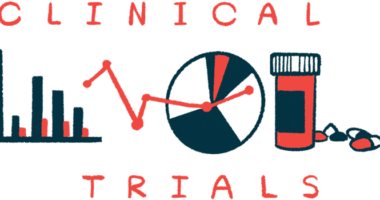Muscular dystrophy symptoms
Last updated Sept. 5, 2025, by Lindsey Shapiro, PhD

The cardinal symptom of muscular dystrophy (MD), a group of more than 30 genetic muscular disorders, is progressive muscle weakness.
Beyond issues with movement, however, people with different types of MD can also experience a range of additional symptoms, often including spinal deformities, fatigue, and cognitive problems. Heart issues, difficulties with breathing, and problems with speaking or swallowing can also occur.
While these MD symptoms typically have a substantial impact on quality of life, an early diagnosis and a prompt start on MD treatment can help keep symptoms under control and slow their progression.
Common symptoms of muscular dystrophy
Mutations in genes that are important for muscle health are the underlying causes of MD, leading to muscle weakness and wasting (atrophy) that progressively worsen over time. Other common MD signs and symptoms include orthopedic issues and fatigue.
Muscle weakness and motor problems
Weakness and muscle wasting in MD commonly affect the skeletal muscles needed for voluntary movement, leading to balance and mobility issues that make it harder to do everyday tasks.
Exactly what this looks like depends on several factors, such as which muscle groups are impacted, disease severity, and the person’s age. Possible symptoms of MD may include:
- delayed motor milestones in children, such as sitting up, crawling, or walking
- frequent falls and clumsiness
- trouble running, jumping, walking, or climbing stairs
- difficulty rising from a sitting or lying position
- waddling gait, resulting from weakness in hip and leg muscles
- walking on the toes, as a compensatory strategy for weak muscles and joint stiffness
- trouble using the arms and hands, like when reaching toward, lifting, or gripping objects
- muscle or joint pain and stiffness
When children struggle to stand up, they may use a compensatory mechanism, in which their hands appear to climb up their legs, to get themselves upright. That mechanism, known as Gower’s sign, is a standard symptom of the most common form of MD, Duchenne muscular dystrophy (DMD).
People with MD may also have noticeably enlarged calf muscles, which is known as pseudohypertrophy. This arises when healthy muscle fibers are replaced by excessive fat and connective tissue. It’s typical in DMD and its milder form, Becker MD (BMD), and is also among the limb-girdle muscular dystrophy symptoms.
Among the core myotonic dystrophy symptoms is myotonia — difficulty in relaxing muscles after they contract — which can lead to motor issues like difficulty releasing a grip.
As muscle degeneration in MD advances, a loss of certain muscle reflexes may also be observed.
Orthopedic problems
Progressive muscle loss and weakness in the muscles that normally support the spine, feet, and ankles can lead to bone problems. Among such probles are:
- scoliosis, a sideways curvature of the spine
- lordosis, or an inward curvature of the spine
- foot deformities
- contractures, where muscles and tendons around joints become short and inflexible, leading to joint stiffness
These orthopedic problems can contribute to postural issues, pain, mobility problems, and breathing difficulties. Some people with MD also have weak bones that are prone to fractures.
Fatigue
Fatigue, a feeling of persistent and overwhelming exhaustion, is commonly reported by people with MD, and many describe it as their most debilitating symptom.
This symptom may arise as a direct consequence of muscle weakness, or secondarily to a sedentary lifestyle, sleep disturbances, pain, or stress or anxiety. Breathing and heart problems, which can occur in some forms of MD, can also contribute to fatigue.
Other possible symptoms of muscular dystrophy
Beyond the skeletal muscles used for movement, MD can affect other muscle groups in the body, driving other symptoms. How likely these issues are to occur depends on which form of the disease a person has.
Breathing and heart problems
MD can impact the heart muscles, making it harder for the organ to pump as well as it should, or to beat with a normal rhythm. Heart problems in MD can eventually cause symptoms like fatigue, shortness of breath, abnormal heartbeats, swelling in the legs and feet, and poor appetite.
Cardiac problems are among the most common DMD symptoms, being virtually universal in Duchenne patients. They can also occur in people with BMD, Emery-Dreifuss MD, and myotonic MD.
MD can also interfere with the muscles needed to move air in and out of the lungs, leading to breathing problems such as shortness of breath, wheezing, and sleep disturbances related to poor oxygen delivery.
Face, neck, and throat muscle weakness
Weakness in the muscles of the face, throat, and neck is prominent in some forms of MD. This weakness can manifest as:
- drooping eyelids (ptosis)
- difficulty fully closing the eyes
- difficulty smiling or making other facial expressions
- speech problems
- difficulty swallowing
Swallowing issues can make it difficult for people with MD to maintain adequate nutrition. Such issues also increase the risk of aspiration pneumonia, a lung infection that arises when food or liquid is mistakenly inhaled into the airways instead of being swallowed.
Eye problems are associated with vision loss in some forms of MD, including congenital muscular dystrophies, myotonic dystrophies, facioscapulohumeral muscular dystrophy, and oculopharyngeal muscular dystrophy.
Cognitive difficulties
Some forms of MD, particularly those with onset in childhood, are associated with cognitive difficulties. Such issues may include:
- learning disabilities or developmental delays
- attention deficits
- language and speech delays
- memory problems
- issues with planning, organizing, and executing tasks
In contrast to other MD symptoms, cognitive issues are often not progressive, meaning they remain relatively stable over time.
Early signs of muscular dystrophy
The early signs of MD depend on the specific disease type a person has and the age of disease onset. Recognizing these symptoms can help families know when to seek medical evaluation.
Infants and toddlers
For infants and toddlers, many caregivers first notice a problem when their child doesn’t achieve motor milestones as they’re expected to, taking longer than their peers to roll over, sit up, crawl, or walk. Other possible signs of MD in this age group include:
- a so-called floppy appearance, where babies seem unusually limp due to a lack of muscle tone
- difficulty swallowing or sucking during feeding
- early walking difficulties, like frequent falls, obvious clumsiness, or a waddling gait
- enlarged calf muscles
- skeletal deformities, such as clubfoot, in congenital MD
Children
Signs of MD often become more apparent in early childhood. MD symptoms in children may include:
- persistent mobility issues, like trouble walking or climbing stairs
- frequent falls
- waddling gait or toe-walking
- muscle or joint pain and stiffness
- enlarged calf muscles
- learning, behavioral, or speech difficulties
Adults
Many forms of MD manifest in childhood, but some have an onset in later adolescence or adulthood. Early MD symptoms in adults may include:
- loss of strength or endurance during normal physical activities, like climbing stairs or lifting objects
- falling easily or general clumsiness
- tiring easily or quick muscle fatigue during exercise
- muscle pain or cramps
- joint tightness
How muscular dystrophy symptoms progress and affect daily life
All forms of MD are progressive, meaning muscle weakness and degeneration get worse over time, leading to increasing difficulty with motor skills and interference with daily life.
However, the rate of progression of muscular dystrophy symptoms varies substantially by disease type. For example, people with DMD often start having symptoms in early childhood and completely lose their ability to walk by early adolescence. Conversely, Becker muscular dystrophy symptoms occur later in life, progress more slowly, and do not universally necessitate a wheelchair.
Problems like heart disease and spinal deformities also tend to become more pronounced over time, requiring more significant intervention to prevent life-threatening complications.
There is no cure for MD, but appropriate treatment can help slow its progression, ease symptoms, and prevent complications. Mobility and assistive devices, as well as home modifications, may also make living with MD easier.
Muscular Dystrophy News is strictly a news and information website about the disease. It does not provide medical advice, diagnosis, or treatment. This content is not intended to be a substitute for professional medical advice, diagnosis, or treatment. Always seek the advice of your physician or other qualified health provider with any questions you may have regarding a medical condition. Never disregard professional medical advice or delay in seeking it because of something you have read on this website.







